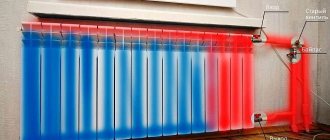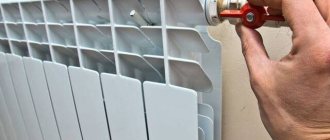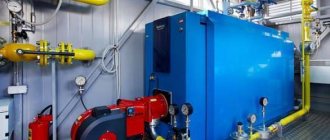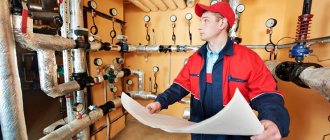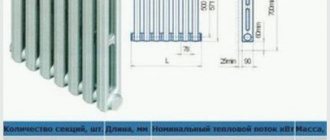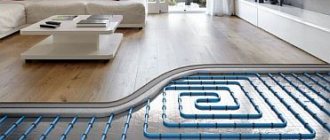Harmful air in the heating system
First of all, it is necessary to understand what danger the air that gets into it poses to the heating system. But the problem is quite simple - air locks in the heating system completely paralyze the operation of the heating system along its entire length or in a separate area.
It's all about a small pressure difference at the inlet and outlet of the system - this value usually does not exceed 0.2 kgf/cm. This pressure is not enough to level out the difference in the density of water and air. Because of this, the upper part of the riser is completely filled with air, and the coolant simply cannot circulate. As a result, apartments are left without heating, and when cold weather sets in, a section of the system completely freezes.
The problems do not end with the phenomena described above. In multi-storey buildings built back in Soviet times, pipes made of ordinary steel are still used. The humidity in the heating system is high, and black steel in such conditions, upon contact with air, begins to deteriorate at a manifold accelerated rate. The result is predictable - at some point the system becomes completely inoperable. To prevent this from happening, you will have to figure out how to bleed air from the heating system.
Why are air locks dangerous?
Air getting inside a water heating system is a very common phenomenon. And you should respond to it immediately. While some air in the system may not seem dangerous, it can often cause more serious problems.
And sometimes airiness of the radiator or pipes makes it possible to identify breakdowns or flaws in the installation of the heating system.
The presence of air locks usually manifests itself in the form of uneven heating of individual system elements, for example, radiators.
If the device is only partially filled with coolant, its operation can hardly be called effective, since the room does not receive part of the thermal energy, i.e. doesn't warm up.

If the top of the heating radiator remains cold and only the bottom warms up, the device is most likely airy, you need to bleed the air
If air has accumulated in the pipes, it prevents the normal flow of coolant. As a result, the operation of the heating system may be accompanied by quite loud and unpleasant noise.
Sometimes part of the system begins to vibrate. The presence of air in the circuit causes the activation of various chemical processes, for example, it can cause the decomposition of calcium and magnesium bicarbonate compounds.
This leads to the formation of carbon dioxide, which disrupts the acid-base balance of the coolant. Increased acidity increases the corrosive effect on heating system elements, which can lead to a noticeable reduction in their service life.
In addition, chemical processes occurring under the influence of high temperatures cause the deposition of limestone deposits on the walls of pipes and radiators, creating a dense coating.
As a result, the pipe clearance decreases, the characteristics of the heating system change, and it operates with less efficiency. A large amount of limescale can completely clog the pipes; they will have to be cleaned or even completely replaced.

The presence of air in an autonomous heating system may indicate processes that contribute to the appearance of sediment and clogging of the heating circuit pipes
If a circulation pump is included in the heating circuit, the presence of air in the system can adversely affect its operation. The bearings of this device are designed to withstand constant exposure to an aquatic environment. If air gets into the pump, the bearing will run dry, causing it to overheat and fail.
Causes of air in batteries
At first glance, it may seem that there is simply nowhere for the air in the batteries to come from, since the heating system is full all year round. Nominally this is the case, as all existing standards say - but in practice it is simply impossible to maintain the tightness of the system all the time, and over time this provokes the removal of an air lock in the heating system.
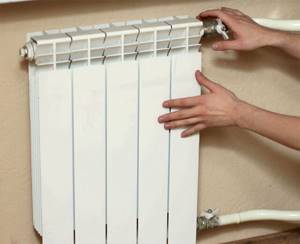
Air appears in batteries due to the following factors:
- Seasonal repair and maintenance work . At least once a year, the heating system must be checked and, if necessary, repaired. According to the instructions, you need to fill the circuit after replacing each structural element - but this will take too much water, so housing and communal services do not incur such costs.
- Replacement of heating devices . Another reason for the appearance of air in radiators is their replacement or removal by apartment residents. Of course, every discharge of the riser can cause it to become airy.
- Physical processes . When all the valves are closed and the pipeline is cooled, the volume of coolant contained in it decreases. If in such a situation you open at least one valve, the batteries will become airy, and you will have to think about how to bleed the air from the battery.
- Damage to system elements . The weakest link in the heating systems of apartment buildings are cast iron radiators, which, when the heating is turned off, begin to leak due to thermal expansion. At some point, you have to solve a serious problem - change all the batteries in the entrance or simply reset the system before the heating season begins.
Signs of airing
Airing leads to inefficient operation of the heating system, as a result of which unnecessary resources are spent on heating the coolant. This leads to unjustified financial expenses and can significantly affect the family budget during the cold season. Signals if the heating system is airy are the following:
- No heating of heat exchangers. Air in the heating circuit in the form of a plug prevents the coolant from passing through the pipes, as a result of which it does not flow to the radiators or into the underfloor heating pipeline. If air gets into the supply pipes, the radiators and floors remain cold when the boiler is operating at full power.
- Uneven heating of radiators. If there is air in the heating radiators, one of its parts will have a lower temperature, which can be easily determined by touching the surface of the sections with your palm.
- Increased noise. The movement of coolant in a pipeline circuit with air pockets is often accompanied by noise, which causes the movement of microbubbles.
- Vibrations. An increased concentration of air in the coolant leads to an acceleration of oxidative processes due to the oxygen contained in it, accompanied by the decomposition of metals with the formation of salts and carbon dioxide. Periodic emissions of insoluble metal oxides and carbon dioxide into the coolant can cause vibration processes in pipes.
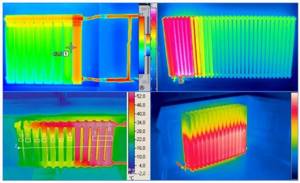
Rice.
2 Air-filled radiators in a thermal imager Date: September 25, 2021
Methods for bleeding air
Several methods are used to bleed air from the heating system, which you need to choose depending on two factors:
- Heating configuration . Since there are differences in the bottom and top filling systems, the air is released from them differently.
- Relation to the heating system . Residents of apartments bleed air from batteries in a completely different way than professional locksmiths do - the tasks are too different, requiring different solutions.
Before removing air from the heating system, you need to consider all the methods in more detail.
Where does the air come from?
Here are the main reasons for the formation of an air lock:
- Replacement of heating devices in apartments. It is performed mainly in the summer, outside the heating season. After pressure testing, the riser is simply filled with water, and the air from it is safely left to bleed until the fall;

Replacing the convector with a bimetallic radiator.
- Inspection of shut-off valves on risers. It is associated with the need to completely dry the heating circuit;
- Inspection of shut-off valves in the elevator unit. And in this case the heating circuit is completely reset;
- Water leaks through threaded connections with broken tightness, intersection connections of radiators, valve seals, fistulas in pipes, etc. When the valves in the elevator are closed and in good working order, they lead to a gradual drop in pressure in the circuit. It is worth opening the flusher or the Mayevsky tap on one of the upper floors - and the vacuum that has arisen in the upper part of the circuit will suck in air.

Mayevsky tap on a heating radiator.
Bottom filling with user access
A distinctive feature of the bottom filling is the pairwise connection of heating risers. In this scheme, the supply and return bottlings are located in the basement of the building, and valves are located between them with risers. Either plugs or taps are installed behind the valves, allowing water to be drained if necessary.
During lower filling, the air present in the risers of the system is squeezed out into the upper sections of the risers connected in pairs. On the top floor (usually in apartments, but sometimes in the attic) there is a jumper between the risers, near which a Mayevsky valve is installed, which allows air to bleed from the system.
First of all, residents of apartments on the upper floors need to know how to remove an air lock from a heating system:
- The tap turns 180 degrees and air begins to hiss out of it;
- When water starts flowing from the radiator, the tap must be closed.
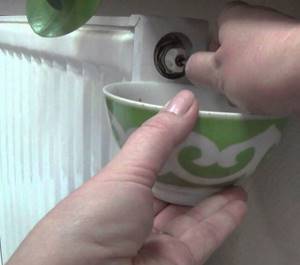
When living on any other floor, it will be enough to ask the neighbors above to bleed the air in their free time. If for some reason it is not possible to come to an agreement with the neighbors, you will need to submit an appropriate application to the local housing organization. The main thing is to ensure that the application is accepted in accordance with all the rules, and then if problems arise with heating, it will be possible to request a recalculation in the future.
Removing air from systems in an apartment building
In order for all the batteries in a multi-storey building to be hot, the coolant must constantly move within them. In houses with centralized heating, water acts as a carrier of thermal energy.
The heating main consists of two threads - supply and return. In this case, in operating mode, the pressure difference between them is at least 2 kgf/cm2. The heated coolant from the supply enters the heating circuit not from the heating main, but after connecting with water flowing through the return line. The function of obtaining mixed liquid is assigned to a water-jet elevator, which is a tee made of steel or cast iron with a nozzle located inside it.

Thanks to partial recirculation of water, the highest speed of its movement in the circuit and the minimum temperature difference between the first and last radiator in the building heating system along the movement of the coolant are ensured.
The difference in pressure between the supply pipe and the return pipe in the battery is 0.2 kgf/cm2. This indicator corresponds to the pressure of a two-meter water column. The presence of air does not allow water to circulate, so information on how to remove an air lock from a heating system will not be superfluous for many property owners.
The fact is that the presence of a small difference prevents the plug from being pushed down due to a significant difference in the density of the air and the working environment. To remove air from the heating system, the hydraulic pressure expressed in meters must exceed the height of the bottling risers.
Bottom Filling with Administrator Access - Air Lock Removal
It’s one thing if the problem can only be solved from your own apartment or by contacting specialists. It’s another matter if you can play the role of a specialist yourself, for example, by gaining access to the basement.
The solution to the problem in this case is as follows:
- Before removing air from the heating system, it must be bypassed, for which the heating valve is first closed and the sewer discharge located underneath is opened;
- After completing the previous steps, the system should be given about 5-10 minutes to release air;
- If the desired effect is not achieved, the system must be turned in the opposite direction;
- After bleeding the air, you need to close the vent and return all valves to their original positions so that the heating circuit continues to function as normal.
Individual risers with which problems have arisen can also be transferred from the basement level. To do this, it is enough to close the valve of one of the connected risers and open the discharge. The probability of successful bleeding of air in this case is quite high, and if one of the risers is used as an idle pipe, then the work will certainly be crowned with success.

Even if plugs are installed on the risers instead of vents, there are a couple of ways to get rid of an air lock in the heating system:
- The first option is to shut off both risers, reset them, and then replace one of the plugs with a ball valve with a male-female thread. Of course, this option will require the faucet itself - but its cost is low, and such costs are certainly worth it so that the heating system can continue to operate.
- For the second option, you need to close the valves located on the risers, and then unscrew one plug. The riser is put into reset mode, stops, and then the previous operations are repeated in reverse order. This method of bleeding air can only be used when the coolant temperature is below 45 degrees - otherwise the person performing this work may be seriously burned.
Why is this necessary?
Apartment house
I'll start from afar.
In order for the radiators on all floors and in all apartments to heat, coolant must continuously circulate in them.
As a rule, in an apartment building this role is played by ordinary water.
The pressure difference between the heating main lines (supply and return) in normal mode is at least 2 kgf/cm2. However, hot supply water enters the heating circuit not directly from the heating main, but after mixing with return water. A water jet elevator is responsible for preparing the mixture - a cast iron or steel tee with a nozzle placed inside.
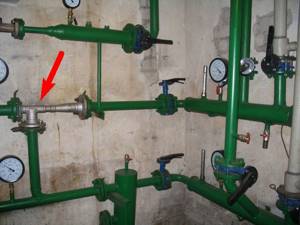
The water jet elevator is the heart of the home heating system.
Recirculation of part of the coolant ensures the maximum speed of its movement in the circuit and the minimum temperature spread between the first and last heating devices along the water flow.
The pressure difference between the mixture entering the batteries and the return is much less than between the threads of the heating main: it is only 0.2 kgf/cm2, which corresponds to a water column pressure of two meters. Airiness in the heating system will simply prevent water from circulating: such a small difference will not be able to squeeze the air plug down due to the significant difference in density between air and water.
To remove an air lock, the hydraulic pressure in meters must exceed the height of the circuit (in an apartment building - the height of the bottling risers).
Autonomous circuit
An autonomous heating system with forced circulation of coolant has a different picture. In most cases, the pressure created by the circulation pump exceeds the height of the circuit, and it can work even if there is air in the pipes.

Heating diagram for a two-story house. The maximum height difference is about 4 meters.
However, when air bubbles move in pipes and radiators, hydraulic noise will inevitably arise. It is unlikely that the owner will be pleased with the continuously gurgling sounds emanating from the battery.
In addition, air contributes to the corrosion of steel circuit elements - black steel pipes, steel panel radiators and bimetallic battery cores. In the absence of oxygen, contact with water does not cause rust .
Top filler with administrator access
If the building uses top filling, this means the following: the coolant supply point is in the attic, and the return circuit is located in the basement. With this configuration, the risers are connected from below and from above, while having the same functional load, so the system maintains an equal temperature within the same floor.
When the circuit is started, air from the radiators moves through the risers into the supply line, and then enters the expansion tank located at the top of the system. Before you bleed air from the heating radiator, you will first need to open the house valves, then go out into the attic and open the tap built into the tank. After some time, the air will simply be squeezed out of the system, and the coolant can continue to circulate calmly. Read also: “How to bleed air from a heating radiator correctly - theory and practice.”

Briefly summarizing, we can say the following - in the absence of experience and understanding of how the heating system works in an apartment building, it is better not to think about how to bleed the air from the radiator yourself. For example, when filling from above, there is a considerable risk of flooding of apartments located on the upper floors, so it is better to entrust such work to specialists from a housing company.
Scenario 3: open heating system of a single-family house
An open system operates at a pressure corresponding to the height of the water column between the lower and upper points of the circuit.
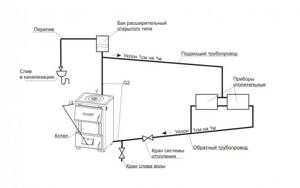
Open system with natural circulation.
The bottling is laid with a constant slope, and an open expansion tank is mounted at its top point.

Open tank.
It combines several functions at once:
- The expansion tank itself, which compensates for the increase in coolant volume when heated;
- A safety valve that relieves excess pressure when the coolant boils in the boiler heat exchanger;
- Air balloon. All air is displaced to the upper part of the circuit, into the expansion tank and further into the atmosphere.
Obviously, such a scheme needs additional air vents much like a fish needs an umbrella. However, they can be equipped with separate heating radiators installed above the filling: Mayevsky taps will allow you to remove air from the radiator and force water to circulate through both of its collectors.
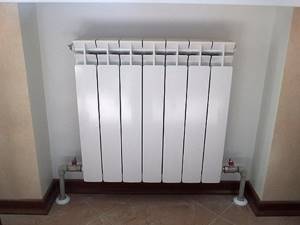
The heating device is located above the bottling and will collect air.
How to bleed air from batteries in a private house
In private homes, a situation may also arise in which air appears in the heating system. What is important is not how the heating system in a private house is aired, but how to get rid of unnecessary air. There is no universal solution to this problem - the heating of a private house is usually designed individually, so the assembled structure has a lot of its own nuances.

However, all types of heating systems have similar features that need to be studied before bleeding air from the battery:
- If the heating has forced circulation, then special air exhaust elements are always installed near the pump (as a rule, they are located either in front of the pump or directly in the boiler). Air in the system in the presence of such elements is most often due to their clogging.
- Air vent valves can also be installed directly on batteries, but only if they are located above the filling point. If the bottling is located somewhere at the upper level, then the air valve should be looked for at its highest point.
- All vertical bends of the filling have their own air vents. If they are absent, you will have to use one of the methods described above to bleed air.
Before you bleed the air from the battery, you need to make sure that the heating system is started correctly - sometimes the reason for its stopping is a valve that is closed in one of the sections.
Scenario 4: closed heating system of a single-family house
In a forced circulation circuit operating at excess pressure, an automatic air vent is usually installed. It is part of the boiler safety group and is installed at the outlet of its heat exchanger.
Some boilers are equipped with their own safety group located inside the housing.
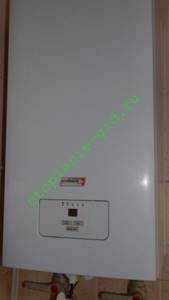
The photo shows a boiler in the body of which a safety group and an expansion tank are mounted.
All heating devices located above the bottling points are additionally equipped with their own automatic air vents or Mayevsky taps.
An air vent is absolutely necessary only when the radiator is connected to the side or diagonally. Double-sided bottom connection allows operation of an air-filled battery. Air is forced into the upper collector, water circulates through the lower one, and the sections are heated throughout their entire height due to the thermal conductivity of the metal.
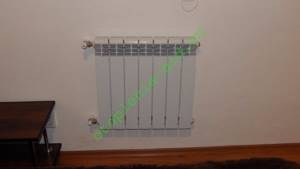
One way side connection. The radiator is located above the filler. An air vent is necessary.
A special case
Along with the air vent, another device is used in closed autonomous systems - an air separator for heating. Its function is to remove small air bubbles that saturate the coolant and contribute to corrosion of steel pipes, erosion of the circulation pump impeller and boiler heat exchanger.
The removal of air from the air chamber of the separator is carried out by our old friend - an automatic air vent.
The following may be responsible for collecting air bubbles:
- The so-called PALL - rings;
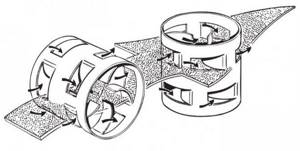
Design and principle of operation of PALL rings.
- Stainless steel or copper meshes.
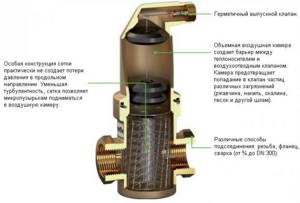
Separator with stainless mesh.
The price of the most affordable separators for a connected pipeline diameter of 20 mm starts from about 2000 rubles, and the benefits they bring are quite doubtful. In my opinion, it is quite possible to do without these devices in an autonomous heating system.
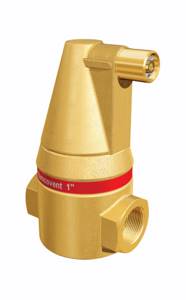
Flamcovent separator for 1 inch pipe. Retail price - 5550 rubles.
Safety precautions and preventive maintenance
To avoid injuries and other problems, you need to follow a number of rules when bleeding air:
- The rod from the air valve cannot be unscrewed - the pressure of the heated coolant will not allow it to be screwed back on;
- The body of the tap also cannot be turned out - it is very easy to break the thread, but it is difficult to eliminate the consequences of flooding the apartment;
- The radiator caps cannot be unscrewed even partially - they cannot be returned later, and boiling water pouring out of the radiators will bring a lot of negative emotions (about
